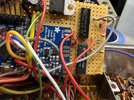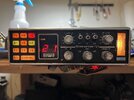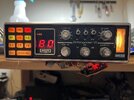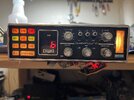First step in hardware integration, the clarifier. Lee Ho Fuk, that was not fun. But after three nights of fiddling code bits to turn an analog voltage into a consistently repeatable digital number, it works. I'm able to go about 2.5kc off center in both directions and back again.
Kind of got lucky on this one. Whoever had unlocked the clarifier previously had been kind of sloppy and just ran a couple of wires from the pot to the T/R relay. Repurposed those to supply 5 volts to the pot and send the wiper voltage over to Arduino pin A6.
The rest was figuring out how get the digitized numbers to stop jumping around like a kangaroo on a meth bender. Averaging for the win on that one.
Next up, SSB offsets.
Kind of got lucky on this one. Whoever had unlocked the clarifier previously had been kind of sloppy and just ran a couple of wires from the pot to the T/R relay. Repurposed those to supply 5 volts to the pot and send the wiper voltage over to Arduino pin A6.
The rest was figuring out how get the digitized numbers to stop jumping around like a kangaroo on a meth bender. Averaging for the win on that one.
Next up, SSB offsets.




